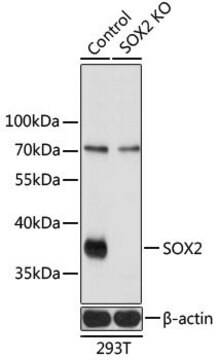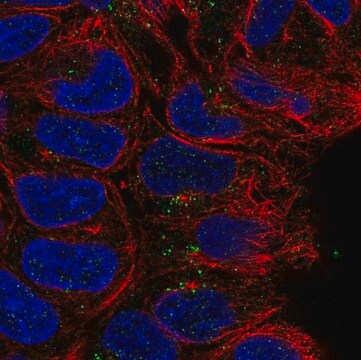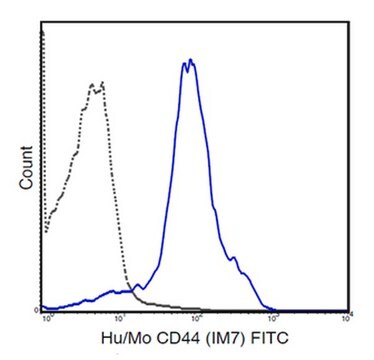SAB4700623
Monoclonal Anti-CD24 antibody produced in mouse
clone SN3, purified immunoglobulin, buffered aqueous solution
Sinonimo/i:
Anti-CD24
Autenticatiper visualizzare i prezzi riservati alla tua organizzazione & contrattuali
About This Item
Codice UNSPSC:
12352203
NACRES:
NA.41
Prodotti consigliati
Origine biologica
mouse
Livello qualitativo
Coniugato
unconjugated
Forma dell’anticorpo
purified immunoglobulin
Tipo di anticorpo
primary antibodies
Clone
SN3, monoclonal
Stato
buffered aqueous solution
Reattività contro le specie
human
Concentrazione
1 mg/mL
tecniche
flow cytometry: suitable
Isotipo
IgG1
N° accesso NCBI
N° accesso UniProt
Condizioni di spedizione
wet ice
Temperatura di conservazione
2-8°C
modifica post-traduzionali bersaglio
unmodified
Informazioni sul gene
human ... CD24(100133941)
Descrizione generale
The antibody SN3 reacts with CD24, a 35-45 kDa heavily glycosylated cell surface antigen. CD24 is expressed by granulocytes, B lymphocytes and by some activated T cells and T cell malignancies. It is not expressed on human thymocytes.
Immunogeno
Glycoproteins purified from human NALM-1 cell line
Applicazioni
The reagent is designed for Flow Cytometry analysis. Suggested working dilution for Flow Cytometry is 2-8 μg/mL of sample. Indicated dilution is recommended starting point for use of this product. Working concentrations should be determined by the investigator.
Caratteristiche e vantaggi
Evaluate our antibodies with complete peace of mind. If the antibody does not perform in your application, we will issue a full credit or replacement antibody. Learn more.
Stato fisico
Solution in phosphate buffered saline, pH 7.4, with 15 mM sodium azide.
Esclusione di responsabilità
Unless otherwise stated in our catalog or other company documentation accompanying the product(s), our products are intended for research use only and are not to be used for any other purpose, which includes but is not limited to, unauthorized commercial uses, in vitro diagnostic uses, ex vivo or in vivo therapeutic uses or any type of consumption or application to humans or animals.
Non trovi il prodotto giusto?
Prova il nostro Motore di ricerca dei prodotti.
Codice della classe di stoccaggio
10 - Combustible liquids
Punto d’infiammabilità (°F)
Not applicable
Punto d’infiammabilità (°C)
Not applicable
Scegli una delle versioni più recenti:
Possiedi già questo prodotto?
I documenti relativi ai prodotti acquistati recentemente sono disponibili nell’Archivio dei documenti.
Athanassios Vassilopoulos et al.
The Journal of biological chemistry, 289(35), 24202-24214 (2014-07-10)
Drug resistance and cancer metastasis are two major problems in cancer research. During a course of therapeutic treatment in Brca1-associated tumors, we found that breast cancer stem cells (CSCs) exhibit an intrinsic ability to metastasize and acquire drug resistance through
Thomas Hofner et al.
Urologic oncology, 32(5), 678-686 (2014-03-19)
To evaluate CD24/CD44/CD47 cancer stem cell marker expressions in bladder cancer (BCa) and provide data on their prognostic significance for clinical outcome in patients undergoing radical cystectomy (RC). Primary BCa tissue was used for xenograft studies. A tissue microarray was
Martine Croset et al.
Journal of bone and mineral research : the official journal of the American Society for Bone and Mineral Research, 29(8), 1886-1899 (2014-03-13)
The transcription factor TWIST1 induces epithelial-mesenchymal transition and/or escape to the oncogenic-induced failsafe program, facilitating the intravasation of breast cancer cells in the systemic circulation and their dissemination to the lungs. Its involvement in breast cancer bone metastasis is unknown.
Ying Zhong et al.
Medical oncology (Northwood, London, England), 31(3), 864-864 (2014-02-13)
Breast cancer stem cells are thought to be associated with metastasis and poor prognosis, but their clinical importance remains poorly understood. The aim of this study was to investigate whether certain phenotypes of breast cancer stem cells were clinically important
Chelsea M Black et al.
Cancer immunology research, 2(4), 307-319 (2014-04-26)
A major barrier to vaccines in cancer treatment is their failure to activate and maintain a complete cancer-specific CD8(+) effector T-cell repertoire. Low-avidity T cells are more likely to escape clonal deletion in the thymus when compared with high-avidity T
Il team dei nostri ricercatori vanta grande esperienza in tutte le aree della ricerca quali Life Science, scienza dei materiali, sintesi chimica, cromatografia, discipline analitiche, ecc..
Contatta l'Assistenza Tecnica.








